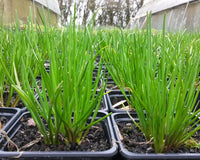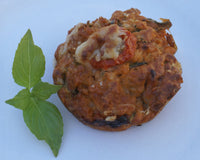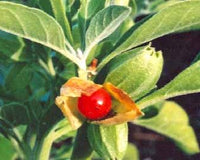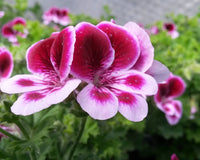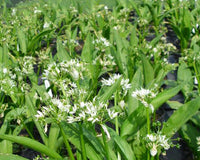We recently received a delightful email from a lovely customer, Elaine, who has turned her garden into her very own herbal tea plantation. Elaine’s enthusiasm for using pelargoniums to create delicious tisanes and enhance her culinary creations inspired us. In this blog post, we will share Elaine's secrets and tips for making the most out of your pelargoniums, with three different methods to make a tisane, along with some bonus culinary suggestions at the end.
What is a Tisane?
Before we jump into Elaine's wonderful tips, let's quickly cover what a tisane is. Unlike traditional teas made from Camellia sinensis leaves (the traditional tea plant), tisanes are caffeine-free infusions made from herbs, flowers, and other plant materials. They are often consumed for their soothing properties and refreshing taste and they also offer a creative outlet for experimenting with different flavour combinations.
What are Pelargoniums (or Scented Geraniums)?
Pelargoniums, commonly known as scented geraniums, are beautiful garden and house plants that often flower over summer. They are easy to look after and love the sun. These plants come in numerous varieties, with different coloured flowers and leaves that offering unique scents and flavours. You can view our range of Pelargonium plants here
Make Your Own Pelargonium Herbal Tea At Home
Pelargoniums are an excellent choice for tisanes because they offer a delightful range of flavours and aromas, from citrusy hints to deep, rose-like scents so you can really get creative with flavour combinations. Elaine has shared her three favourite methods for using pelargoniums in her herbal infusions...
How to Make a Tisane: Hot Water Method
For a fresh and uplifting tisane...
- Pick a good handful of leaves, including Attar of Rose and something lemony like Lemon Fizz or lemon verbena.
- Add a couple of sprigs of either spearmint or apple mint. Avoid stronger mints like Black Pepper Mint.
- Place these ingredients into a warmed teapot, along with any spent flowers.
- Pour boiling water over the mix and leave it to infuse for 4-5 minutes.
Elaine assures us, "You will think it looks like hot water, but wait until you taste it – very cleansing and uplifting. You can add other herbs too – rosemary, bay leaves, sage, golden oregano, sweet cicely. Have some fun experimenting to find out what you like and the quantity you need for your pot size. Things like blackcurrant leaves are a good addition too. My main focus is always to include the scented pelargoniums as they really lend themselves to use in this way, with the natural oils in the leaves being released in the hot infusion."
Cold-Infused Pelargonium Tisane
Elaine's next, and favourite, method involves cold infusion. She recommends:
- Pick a selection of leaves and blooms, including mint, Attar of Rose, Lavender Lindy, and Ardwick Cinnamon as well as a mix of different pelargonium leaves and flowers.
- Add a sage leaf or two, lemon verbena, a sprig of rosemary, golden oregano, marigold heads, a bay leaf, a sprig of herb fennel.
- Pack the leaves into a pot with a plunger, such as a cafetiere (used solely for this purpose).
- Fill the pot with cold water and leave it to sit out of direct sunlight for 24 hours (no longer as otherwise you risk getting unwanted bugs growing in the water).
- Strain off the infusion and store it in the fridge.
Elaine notes, "The infusion is different every time and completely refreshing and lovely to drink".
Dried Flower Tisane
Elaine also enjoys making tisanes from dried flowers. She suggests:
- Pick fading flowers regularly (eg once a week) and air dry.
- Over the season you will build up a lot and these can then be mixed torn up bay leaves, a little lavender, crushed blackcurrant leaves and dried marigold and cornflower petals.
Elaine says, "Every year the mix is different but it’s lovely mixed with spearmint or
peppermint tea for an evening tea after dinner".
Suggestions for using Pelargoniums in Culinary Creations
Elaine's kitchen creativity extends beyond tisanes and she has given us lots more ideas:
🫐Fermented Fruits: Add pelargoniums to fermented gooseberries or blackcurrants for a delightful background flavour.
🍇Pickled Fruits: Use some pelargonium leaves in pickled blackberries to enhance their taste.
🍓Jam Making: Incorporate pelargonium leaves at the end of cooking jam to impart their unique flavour.
🍰Baking: Place pelargonium leaves on the base of a polenta cake, then soak the cake with a syrup infused with pelargonium leaves for an aromatic touch. Attar of Rose is particularly excellent for this purpose.
Ready to try experimenting yourself?
We hope this blog post has opened your eyes to the many possibilities of using
pelargoniums in tisanes as well as other culinary creations. Pelargoniums offer a world of flavours waiting to be discovered so we encourage you to try these tips. Browse our range of Pelargoniums (scented geraniums) available to order today and start growing your own herbal tea plantation at home so you can experiment with different blends to find your perfect cup.
For more ideas and to connect with fellow gardening enthusiasts and herbal tea lovers, make sure you subscribe to our newsletter. You can find the sign-up form in the purple box to the right of the article if you're reading this on a desktop computer (or you can find it below this article on mobile), as well as in the footer on every page of our site. And if you would to share your own herbal suggestions, we’d love to hear from you.


